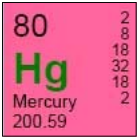Mercury
View/Download PDF Version
Mercury
- Mercury is a silver-white metallic element that is fairly uncommon in the earth’s crust. Mercury is used in thermometers, barometers, vapor lamps, mercury switches, advertising signs and in concentration of metal ores. Potential sources of contamination in drinking water include erosion of natural deposits, industrial discharge, runoff from landfills and croplands and runoff of atmospheric deposition from power plants.
- The USEPA has set a drinking water standard of 0.002 mg/ L for mercury in public drinking
water supplies. These regulations do not apply to private water supplies but the health
implications are the same for private well owners.
- The lethal dose of mercury is approximately 3 to 30 g. It would take over 30,000 gallons of mercury contaminated water at 10 times the USEPA standard to get a 3 g dose. The more likely type of health effect from Hg comes from low dosages over a long period of time or “chronic” effects. Kidney damage is the primary health effect from mercury.
- Treatment of water for mercury can be accomplished with adsorption (i.e. carbon or charcoal), reverse osmosis, or distillation systems.
Additional Resources
Click on the links below to be directed to more resources.
US EPA National Primary Drinking Water Regulations
Water Quality Interpretation Tool
Handbook of Drinking Water Quality; John DeZuane; 1997
